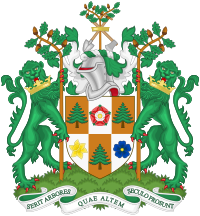
Sequoiadendron giganteum is the sole living species in the genus Sequoiadendron, and one of three species of coniferous trees known as redwoods, classified in the family Cupressaceae in the subfamily Sequoioideae, together with Sequoia sempervirens and Metasequoia glyptostroboides. Giant sequoia specimens are the most massive trees on Earth. The common use of the name sequoia usually refers to Sequoiadendron giganteum, which occurs naturally only in groves on the western slopes of the Sierra Nevada mountain range of California.

The Woodland Trust is the largest woodland conservation charity in the United Kingdom and is concerned with the creation, protection, and restoration of native woodland heritage. It has planted over 50 million trees since 1972.
The Forestry Commission is a non-ministerial government department responsible for the management of publicly owned forests and the regulation of both public and private forestry in England.

Arboriculture is the cultivation, management, and study of individual trees, shrubs, vines, and other perennial woody plants. The science of arboriculture studies how these plants grow and respond to cultural practices and to their environment. The practice of arboriculture includes cultural techniques such as selection, planting, training, fertilization, pest and pathogen control, pruning, shaping, and removal.

An arborist, tree surgeon, or arboriculturist, is a professional in the practice of arboriculture, which is the cultivation, management, and study of individual trees, shrubs, vines, and other perennial woody plants in dendrology and horticulture.

In the United Kingdom, an ancient woodland is a woodland that has existed continuously since 1600 or before in England, Wales and Northern Ireland. Planting of woodland was uncommon before those dates, so a wood present in 1600 is likely to have developed naturally.
The Institute of Chartered Foresters (ICF) is the professional body for foresters and arboriculturists in the United Kingdom. Its Royal Charter was granted in 1982. The Institute grants chartered status to individuals following an examination process that includes a period of management or supervisory experience resulting in them being promoted to professional membership. Chartered members are recognised by the designations 'Chartered Arboriculturist' or 'Chartered Forester' and by the postnominals letters MICFor. Fellows of the institute bear the postnominals FICFor in addition to their designation.
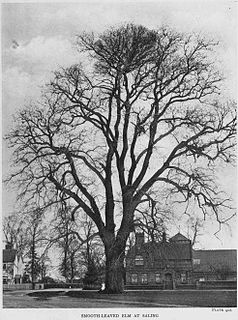
Ulmus × hollandicaMill. , often known simply as Dutch elm, is a natural hybrid between Wych elm Ulmus glabra and field elm Ulmus minor which commonly occurs across Europe wherever the ranges of the parent species overlap. In England, according to the field-studies of R. H. Richens, "The largest area [of hybridization] is a band extending across Essex from the Hertfordshire border to southern Suffolk. The next largest is in northern Bedfordshire and adjoining parts of Northamptonshire. Comparable zones occur in Picardy and Cotentin in northern France". Crosses between U. × hollandica and either of the parent species are also classified as U. × hollandica. Ulmus × hollandica hybrids, natural and artificial, have been widely planted elsewhere.

The Heaton Woods Trust is both the name for the charity and the woodland it cares for located mainly in Heaton, Bradford, West Yorkshire, England but also stretches into Shipley. The Heaton Woods Trust is a registered charity that was established in 1977. The Heaton Woods Trust is responsible for the care and protection of the woods for the benefit of present and future generations.

Llanfyllin is a market town, community and electoral ward in a sparsely populated area in Montgomeryshire, Powys, Wales. Llanfyllin's community population in 2011 was 1,532, of whom 34.1% could speak Welsh. Llanfyllin means church or parish (llan) of St Myllin. The community includes the tiny settlements of Bodfach, Ty Crwyn, Abernaint and several farms.
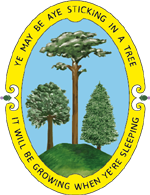
The Royal Scottish Forestry Society was founded in 1854 as the Scottish Arboricultural Society. In 1869, the society received the patronage of Queen Victoria and the "Royal" prefix was added in 1887. The name changed to the current one in 1930.

Tony Kirkham MBE VMH is the former Head of Arboretum, Gardens & Horticulture Services, Royal Botanic Gardens, Kew.
The Confederation of Forest Industries, shortened to ConFor, is the trade association for the forestry industry in the United Kingdom.
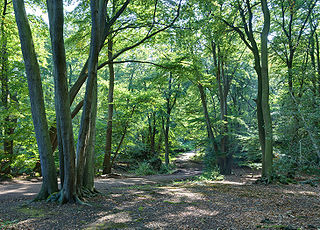
The United Kingdom, being in the British Isles, is ideal for tree growth, thanks to its mild winters, plentiful rainfall, fertile soil and hill-sheltered topography. Growth rates for broadleaved (hardwood) trees exceed those of mainland Europe, while conifer (softwood) growth rates are three times those of Sweden and five times those of Finland. In the absence of people, much of Great Britain would be covered with mature oaks, except for Scotland. Although conditions for forestry are good, trees do face damage threats arising from fungi, parasites and pests. The development of afforestation and the production and supply of timber in Wales come under Natural Resources Wales, as set out in the Forestry Act 1967.

George Ware, Ph.D. (1924–2010) was an American dendrologist and former research director of the Morton Arboretum Illinois who specialized in the evaluation of Asiatic species of elm as urban trees.
The Arboricultural Association is the largest body in the UK for the amenity tree care professional (arboriculturalists).
Since 2017, the Woodland Trust has led 70 United Kingdom organizations in the call for a Charter for Trees, Woods and People.

Puck's Glen is a river-formed ravine on the Cowal peninsula in Argyll and Bute, Scotland, with a popular scenic walking trail beside the Eas Mòr stream. In 2020 the glen and adjoining trails were closed temporarily due to COVID-19 restrictions, issues of stability of the gorge, and felling of trees infected by larch disease.
Ted Green MBE is a British academic, scientist, campaigner and arboriculturist. He has been working in a career bridging forestry and conservation for over 50 years, founding the Ancient Tree Forum in 1993. He is described as "Britain's foremost ancient tree expert". He won the Royal Forestry Society's (RFS) Gold Medal for Distinguished Services to Forestry in 2017.
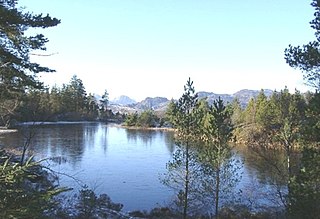
The National Forest for Wales is a long-term forestation programme by the Welsh Government, aiming to form a network of woodland throughout Wales.




